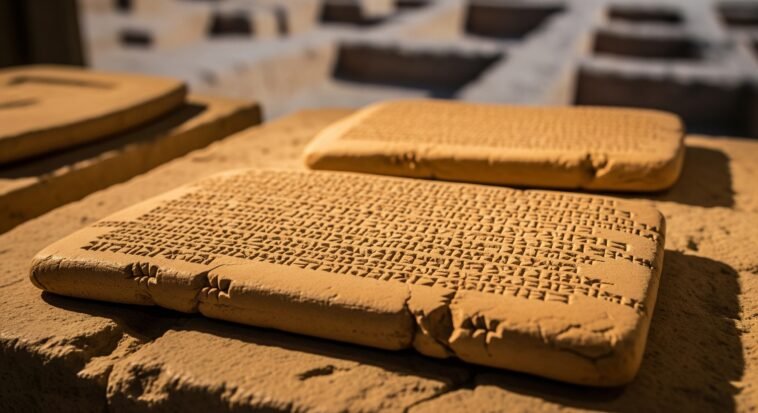
Some objects from history aren’t famous for their beauty—they’re famous for the chaos they leave behind.
Think cursed jewels, haunted tomb loot, or relics with seriously bad vibes.
These artifacts have sparked centuries of freakouts, blending real tragedy with ghost-story energy. Even today, we can’t look away.
Are they cursed? Or is it just our obsession with the spooky unknown?
Either way, it’s giving major Indiana Jones meets Final Destination energy.
What Makes an Artifact “Cursed”?
Before we dive into the creepy cursed objects list, let’s talk about what gives an object that bad mojo vibe in the first place.
Spoiler: it’s not just spooky lighting and dramatic music.
Sacred or ritualistic origins
A lot of these so-called cursed items started out as religious or ritual objects—burial goods, ceremonial tools, that kind of thing.
When someone yanks them out of their original context (usually a tomb), ancient spiritual “terms and conditions” get violated. Cue the supernatural consequences.
Tragic historical context
If the object was present during a betrayal, massacre, or scandalous downfall, people tend to treat it like it absorbed the emotional wreckage.
Think of it as historical bad energy clinging to the artifact like Wi-Fi to your phone.
Documented pattern of misfortune
A true cursed item isn’t just spooky—it has a track record.
Think repeated “accidents,” mysterious deaths, bankruptcies, broken bones—basically a cursed greatest hits album that follows whoever touches it.
Cultural belief systems
Here’s where psychology kicks in.
If enough people are convinced an object brings doom, it starts to affect behavior, decisions, and outcomes.
It’s like a cultural placebo effect… but make it terrifying.

Ancient Civilizations and the Birth of Cursed Objects
Let’s go back—way back—because the whole “this object will ruin your life” thing? Ancient civilizations basically invented it.
Egyptian pharaohs and tomb curses
No one did cursed artifacts like the Egyptians.
They believed in protecting their dead and their bling with magical backup.
Think of it like ancient home security, but instead of motion sensors, they used actual curses.
When Howard Carter cracked open King Tut’s tomb in 1922, it wasn’t just gold and glory—people started dropping like flies.
Lord Carnarvon (the guy funding the dig) died from a mosquito bite gone wrong right after the tomb was opened.
Media freakout ensued. “Pharaoh’s Curse” went viral—1920s style.
And those hieroglyphs? Not just decoration.
They literally said: disturb this and you’re toast. Egyptians weren’t joking.
These curses were meant to scare off grave robbers and spiritually protect the dead on their afterlife road trip.
No one wanted to mess with that.
Mesopotamian tablets and divine wrath
Meanwhile, in Mesopotamia (modern-day Iraq), the ancient scribes had their own brand of cursed energy.
Their clay tablets—whether legal codes, religious texts, or receipts from the world’s first accountants—often ended with divine threats.
Like, “If you erase this law, may the gods curse your crops, your cows, and your sleep.”
Case in point: the Code of Hammurabi.
It didn’t just lay down the laws—it weaponized them.
The final lines read like an ancient Yelp review crossed with a smiting ritual.
Basically: mess with this tablet, and every major deity will make your life a nightmare.
Even their religious charms and amulets came with supernatural warnings.
The message? Don’t steal, deface, or misuse—unless you want Babylonian karma on speed dial.

Medieval Relics and Religious Artifacts
The Middle Ages? Peak era for relic obsession.
Everyone wanted a holy bone, a saint’s sandal, or a goblet with questionable backstory.
But here’s the twist: these sacred objects didn’t just bless—they sometimes cursed, especially if you were shady about it.
The holy grail and Arthurian legend
The Holy Grail is the Beyoncé of cursed artifacts.
Is it real? Who knows. But it’s everywhere in medieval lore—especially in those juicy Arthurian legends.
Depending on the tale, the Grail heals the pure-hearted or totally ruins anyone unworthy.
So basically, it’s the original “are you even spiritually verified?” test.
Knights went questing for it like it was the medieval Infinity Stone—holy, powerful, and potentially lethal if you weren’t ready for it.
The Grail was never just a cup—it was a reflection of medieval guilt, glory, and the belief that divine power doesn’t come without risk.
Blessings for the chosen, doom for the drama kings.
Reliquary objects and saint’s remains
Medieval Europe was basically a holy relic treasure hunt.
Churches showed off saint body parts like concert merch.
Got a tooth from Saint Catherine? Instant street cred. Pilgrims showed up. Donations flowed in.
But here’s the tea: not all relics were peace and prayers.
Some had bad reputations—especially the ones stolen, forged, or used to win political battles.
Mess with a saint’s femur for the wrong reasons, and boom—plagues, fires, sudden downfall.
There are legit records of people dropping dead after stealing relics.
Coincidence? Maybe. But try telling that to a 12th-century monk.
Renaissance and Early Modern Cursed Artifacts
Once we hit the Renaissance, cursed artifacts got an upgrade: glitterier, bloodier, and way more dramatic.
Suddenly, it wasn’t just ancient tombs—now the rich and powerful were accidentally accessorizing with bad juju.
The hope diamond: Beauty and tragedy combined
Meet the Hope Diamond—a stunning 45.52-carat deep-blue gem that looks like it belongs in a heist movie but reads like a horror script.
Originally part of the massive “French Blue” diamond, it got recut, renamed, and passed around like cursed hot potato.
Here’s the kicker: practically everyone who owned this sparkly nightmare hit some serious life turbulence.
- Louis XVI & Marie Antoinette? Wore it → guillotined.
- The Hope family? Gave the diamond its name → spiraled into financial ruin.
- Other collectors? Mysterious deaths, bankruptcies, drama galore.
Coincidence? Maybe. But honestly, if this diamond were a person, it’d be Regina George with a vendetta.
Even now, it lives in the Smithsonian, behind glass, probably plotting.
Cursed crown jewels and royal regalia
Royal jewels have always symbolized power—but steal one, and don’t be shocked if things get Game of Thrones real fast.
Case in point: the Koh-i-Noor diamond, now part of the British Crown Jewels.
Before it was claimed by the British Empire, it passed through multiple dynasties—each one wrecked by war, betrayal, or tragic downfall.
Now there’s a legend that only women should wear it, because whenever a man does… yeah, it doesn’t end well.
And it’s not just one gem—crown jewels in general were cursed magnets, especially when looted during wars or royal overthrows. N
othing like a sparkly symbol of power laced with centuries of bad blood and colonial trauma.

Modern Era: Cursed Artifacts in the Industrial Age
The Titanic and objects of maritime disaster
The Titanic wasn’t just a ship—it was the ultimate flex of early 1900s tech.
Then it hit an iceberg and became the blueprint for every modern disaster movie.
But here’s the spooky part: some people believe it wasn’t just an iceberg that doomed it.
Legend says a cursed Egyptian mummy case was secretly on board. (Historians say that’s probably a myth—but hey, people believed it, and that belief added serious haunted energy.)
Even without the mummy, artifacts pulled from the wreck are said to bring bad luck.
Some families flat-out refused anything connected to the ship—too much tragedy, too many weird vibes.
Now, Titanic souvenirs live in museums… and horror stories.
World War artifacts and battlefield curses
World War I and II? Literal hellscapes.
So it’s no shock that stuff pulled from the trenches and camps sometimes feels… off.
We’re talking helmets, dog tags, and even letters found on battlefields or at concentration camps that make collectors and curators feel straight-up cursed.
Weird dreams, power outages, sudden illnesses—you name it. Some museums even have strict handling rules for certain items because, yeah, the energy’s that heavy.
These aren’t ancient curses—they’re modern trauma trapped in physical form. It’s less magic spell, more historical PTSD with a side of ghost story.
Preservation and Display of Cursed Artifacts
Turns out, museums don’t just worry about glass cases and climate control—they also have to deal with vibes.
Especially when it comes to cursed or “spiritually spicy” artifacts.
Museum protocols
Big-name places like the British Museum and the Met have entire playbooks for dealing with “possibly cursed, definitely sensitive” objects.
They’re not out here claiming ghost stories are facts—but they also don’t dismiss them as nonsense.
They bring in cultural consultants (aka: actual experts from the communities these items come from) to help display things with context.
Because what might look like a spooky trinket to you could be sacred or spiritually active to someone else.
Ethical considerations
Displaying cursed or sacred stuff isn’t just about spooky stories—it’s about ethics.
Museums now realize that not everything should be on display, especially when it comes from indigenous or colonized cultures.
Some of these objects are still considered spiritually “alive” by the people they came from.
That means ongoing conversations, repatriation talks, and, in some cases, giving items back or changing how they’re shown.
It’s not about canceling exhibits—it’s about not being that guy who treats someone’s sacred heirloom like a Halloween prop.
Conclusion: The Enduring Power of Cursed Artifacts
Cursed artifacts aren’t just spooky leftovers from the past—they’re mirrors.
They reflect our fears, guilt, curiosity, and craving for mystery.
Whether you’re Team “It’s Haunted!” or Team “Cool story, bro,” these objects still mess with our heads—in the best way.
In a world ruled by Wi-Fi and logic, cursed items remind us there’s still room for goosebumps and big questions.
They blur the line between history and horror, fact and folklore.
And let’s be real—who doesn’t love a story where a jewel might ruin your life?
So yeah, maybe it’s not about the curse itself.
Maybe it’s about what we project onto these dusty old things—trauma, wonder, drama. The stories survive because we keep telling them.



